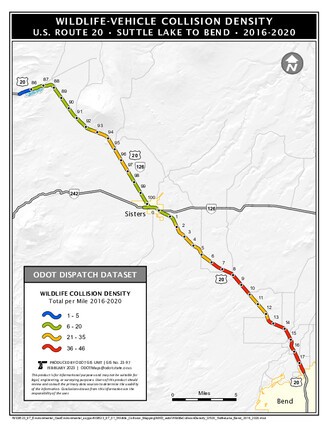Initiative seeks to mitigate wildlife collisions
Last updated 1/16/2024 at 9:50am
In the five years between 2017 and 2021, 721 elk and mule deer were killed in collisions with vehicles on the Highway 20 Bend to Suttle Lake corridor. The heaviest concentration was east of Sisters, and in the Black Butte Ranch stretch there were higher numbers.
Numbers for 2022 and 2023 are not yet available.
The removal of dead animals on state roadways is undertaken by Oregon Department of Transportation (ODOT).
"ODOT is responsible for removing road hazards on state highways, including animal carcasses. Our maintenance crews do a great job of recording when and where large wildlife are moved off the highway. But the data are very conservative since just as many animals that are struck wander off the highway and die elsewhere," Cidney Bowman, wildlife passage coordinator for ODOT told The Nugget.
ODOT is working with partner state and federal agencies and non-profit organizations on a privately funded feasibility study between Bend and Suttle Lake. The density of wildlife-vehicle collisions (WVCs) is quite high - among the highest in the state - and portions of the highway pass through U.S. Forest Service lands. The Oregon Wildlife Foundation is leading the contract for the study, but Central Oregon LandWatch is one of the main leaders of this effort.
"Mitigating collisions is a bipartisan effort," said Jeremy Austin from LandWatch, citing a Pew Research Study that found 86 percent of all Oregonians favored action to reduce the toll.
"Over a period of time, the Oregon legislature has provided $12 million in various funding rounds to find solutions to the problem," Austin said.
The feasibility study to be completed this summer will give planners tools and options to work with by which time more data will have been released.
"We have very good data on migration patterns," Austin said, indicating that they knew where and when Cervidae (deer, elk) roam.
There are about 1.5 million deer and car collisions a year causing more than $1 billion in damage losses. Some 10,000 motorists a year are injured in such encounters with 175 to 200 resulting in death.
With deer and elk frequently on the move during breeding season and migration to winter ranges in the fall and back to summer feeding grounds in the spring, more wildlife are crossing roads statewide.
Oregon has 79,045 miles of roadways across the state, including 4,295 miles of national highways. Drivers travel over 35.8 billion miles on these roads each year. A 2019-2020 report on Animal Collision Likelihood listed Oregon in the "medium risk" category nationwide, with an overall collision rate of 1 in 180, although it has the highest rate of WVCs when compared to other West Coast states, according to the legislature.
In Deschutes County, there is already one active wildlife passage corridor near Sunriver. "The Lava Butte wildlife underpass near Bend is frequented by all sorts of wildlife from elk and deer to bobcats and badgers. As expected, the crossing saves the lives of wildlife and drivers. For instance, deer-vehicle collisions in the area are down by 90 percent," said Celeste Meiffren-Swango, state director of Environment Oregon.
A commissioned study on the other hand shows mixed results when factoring in all the tactics for this corridor that include 13 foot exclusion fencing and jump-outs, a ramp deer can use to get back if they somehow jumped into the highway.
"In conclusion, it appears that the wildlife crossings have provided a means of safe passage for mule deer and other wildlife that routinely cross Route 97; however, the fence and jump-out configuration may be limiting the overall effectiveness of the project," said the report's authors Western EcoSystems Technology.
Most commonly, underpasses (tunnels) or overpasses ( bridges) are used to direct animal crossings across major highways.
The Black Butte Conservancy has a keen interest with the problem as some 200 elk make their home on Black Butte Ranch, and regularly cross Highway 20 in some cases multiple times a day getting from the Ranch to Green Ridge.
Tom Sawyer, a BBR resident and Conservancy member, imagines his group supporting the initiative and lending volunteers to the project as it moves from study to implementation - likely in 2025, possibly 2026.


















Reader Comments(0)